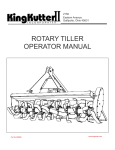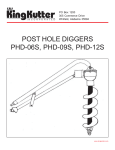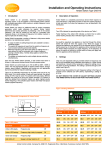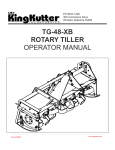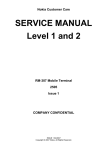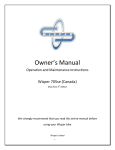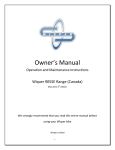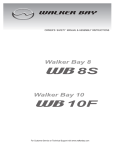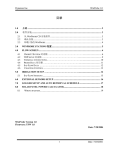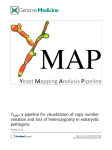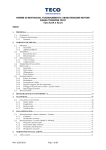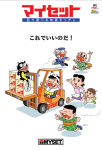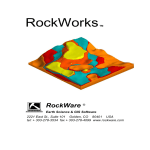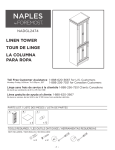Download OPERATORS MANUAL LDS – GROUND DRIVE
Transcript
LDS120/120DS/240/360/700 LDS – GROUND DRIVE SPREADER OPERATORS MANUAL WM1-LDS120 INDEX Section: Description: 1 Page No: 1 Introduction HSE Information Sheet 2 HSE Information Sheet 3 2 In the interest of safety: DO NOT 4 3 In the interest of safety: DO 5 4 Instruction & Warning Decals 6 5 Transporting and lifting the LDS 7 6 Operating instructions and adjustments 6.1 Before use check the following 8 6.2 Distribution 9 6.3 Vane regulation / adjustment 10 6.4 Calibration 10 6.5 Calibration charts LDS120/240/360/700 11 6.6 Calibration charts LDS120DS 12 7 Maintenance 7.1 Daily maintenance 14 7.2 Seasonal 15 8 9 LDS Serial Number: Date of Purchase: Exploded Parts Diagram 8.1 Main frame LDS120/DS 16 8.2 Main frame Parts list LDS120/DS 17 8.3 Spinner and Hopper LDS120/DS 18 8.4 Main frame LDS240/360 19 8.5 Main frame Parts list LDS240/360 20 8.6 Spinner and Hopper LDS240/360 21 8.7 Drive Assembly LDS700 22 8.8 Main frame LDS700 22 8.9 Wheels & Tyres LDS700 23 8.10 Spinner & Agitator LDS700 23 8.11 Parts list LDS700 24 Owner Guarantee 25 Declaration of conformity 26 1 INTRODUCTION With the purchase of your LOGIC LDS – GROUND DRIVE SPREADER you have made an excellent choice. This machine should give first class service for a long time, if used correctly, and maintained as described in this manual. The Ground Drive Spreader range is capable of spreading fertiliser as well as salt depending on which model you have, it is ideal for small holdings or similar smaller areas where a general approach to spreading is required. The hopper capacities range from, 120 - 700lt. being land driven it is essential to maintain a constant forward speed if accurate spread patterns and accurate quantities are to be achieved, therefore an accurate speedometer may be required. The Ground Drive Spreader has a mild steel framework with a galvanised finish to add extra protection from corrosion and harsh working environments. If, after reading this manual there are any queries, please get in touch, we will be pleased to help. NORTH & EXPORT LOGIC MANUFACTURING LTD Foundry Industrial Estate Bridge End, Hexham Northumberland NE46 4JL Tel: 01434 606661 Fax: 01434 608143 E-mail: [email protected] www.logic.gb.com SOUTH LOGIC MH LTD - New Whiteway Works, Fossecross Industrial Estate Chedworth. Cheltenham Gloucestershire GL54 4NW Tel: 01285 720930 Fax:01285 720840 E-mail: [email protected] www.logic.gb.com 1 HSE information sheet Selecting and using equipment for All Terrain Vehicles (ATVs) Agriculture Sheet No 11 Introduction Centre of gravity This information sheet gives advice to users on how to use All Terrain Vehicles (ATVs) safely with towed and mounted equipment. Stability of the ATV is improved if there is: Plan the use of an ATV carefully and take particular note of ground conditions and slopes, as these may vary considerably, depending on the terrain, weather conditions, ground surface and the crop under the wheels. A low centre of gravity which is within the wheel base; A wide wheel base; A long draw-bar; Means for holding detachable equipment in position. Towed equipment Hitching and loads Choose equipment which matches your ATV. Stability of towed equipment is affected by: Stability is also improved if: Weight ratios Some weight is transferred from the trailer onto the ATV draw-bar; The safe ratio between the trailed laden maximum weight and unladen weight of the ATV must be assessed for each operation. Always take note of information given in the manufacturer’s handbook when making this assessment. As a guide research shows that on level ground, 4 x unladen weight of the ATV for braked trailed equipment and 2 x unladen weight of the ATV for unbraked trailed equipment are the appropriate maximum ratios. Note: For work on slopes or uneven ground the ratio will need to be reduced. Braking Fit: The draw-bar has a swivel hitch and the ATV a ball hitch having a large head to neck ratio. This makes it easier for the draw-bar hitch to swivel and cope with undulating ground; The load is positioned as near to the centre of the trailer as possible. Tyres and wheels Check tyre pressures regularly with a pressure gauge capable of reading low pressures accurately; Check tyre pressures regularly for damage and wear; Select equipment which has tyres and wheels that can cope with speeds over 20 mph and occasional higher speeds; Brakes to trailed equipment. This helps prevent jackknifing when braking or travelling downhill; Use wheels with bead locks on the rims if the main use is going to be on sloping ground. This prevents tyre run-off on side slopes. Over-run brakes which come into action whenever the ATV brakes are applied; Maximum towed weight Follow the advice given by manufacturers on the maximum trailed weight. This will be found on the equipment or in the instruction handbook. Note: Universal road going trailers will normally have the maximum gross weight stated on a separate notice. 2 Mounted Equipment Training ATVs using mounted equipment are safer if the equipment has: Train everyone who has to use an ATV whether with mounted or trailed equipment or as a solo machine. The training should emphasise the factors affecting stability, the need for care and concentration, and how to recognise the conditions, which may affect the safety of operation. It is important for trainees to familiarise themselves with the handling and control of the machine on level open ground before tackling rough hill terrain. A low centre of gravity. This improves stability; A gross weight within the limits the limits approved by the ATV manufacturer; No dangerous projections to enquire the operator or bystanders; No forward projections which stop head protection being worn; Suitable training courses are run by such bodies as ATB Landbase and Forestry Authority. Helmets Controls which are easy to work and which do not create a hazard to the operator; Working speeds less than 16hp. Instructions for the mounted and trailed equipment Wear head protection, which protects the head and neck. Helmets to BS 6658:1985 (specification for protective helmets for vehicle users) are suitable. Some users find open faced helmets more suitable than full face helmets. Use of ATV’s for Spraying Take note of the manufacturers instructions on: Operating on slopes; Where to place loads so as to give fore/aft and lateral stability; A separate information sheet No 10 ATV’s fitted with spray equipment is available from the Crop and Pesticides National Interest Group (see address below)to cover the use of mounted or trailed ATV sprayers. The risks of using equipment with negative drawbar nose weight, i.e. loss of traction; Further information The maximum operating speed; The effect that equipment carried on front and/or rear racks will have on longitudinal and lateral stability; Securing loads; The use of ballast, if any to improve stability; HSE Contract Research Report No52/1993 braking and overturning stability of all terrain vehicles with trailed or mounted loads and review of guidelines 1993 ISBN 011 882149 0 HSE safeguarding agricultural machinery: moving parts HS (G) 89 1992 ISBN 011 882051 6. This provides further information on the design of machinery. The need to select and use safe routes. Using an ATV Read the manufactures instruction book and take note of the safety advice given; Choose an ATV with enough power for the work you want it to do. Four wheel drive will give better traction and mobility and may provide a margin of safety; These publications are available from HSE books, PO Box 1999, Sudbury, Suffolk, CO10 6FS (Tel: 0787 881165; fax: 0787 313995). If you need information please contact your local HSE office. Further copies of this information may be obtained from the crop and pesticides national interest group, HSE, Bareback house, Trinity Square, Nottingham NG1 4AU: tel: 0602 470712 Choose a safe route; Be aware that increased speed greatly increases the risk of instability and the risk of an overturn. This publication may be freely reproduced, except for advertising, endorsement or sale purposes. The information it contains is current at 7/94. Please acknowledge the source as HSE. NIS/13/11 Printed and published by HSE 3 C100 This symbol means WARNING or CAUTION Personal safety or damage will be at risk if these instructions are ignored. Most accidents are caused by neglect or carelessness; Avoid needless accidents by following the safety precautions listed below. 2 IN THE INTEREST OF SAFETY: DO NOT 1. DO NOT – Operate the LDS without all the correct guards fitted. 2. DO NOT – Touch any moving or rotating parts, during working conditions 3. DO NOT – Operate the LDS without suitable ear and eye protection 4. DO NOT – Allow passengers. 5. DO NOT – Operate the LDS on excessively steep slopes. 6. DO NOT– Operate the LDS unless all safety features are fitted, and are used correctly 7. DO NOT – Operate the LDS until you have read and understood the entire operators manual 8. DO NOT – Wear loose fitting clothing, to avoid catching on parts of the machine 9. DO NOT – Operate the LDS in Dark conditions unless suitable artificial light is used. 10. DO NOT – Climb on the LDS. 11. DO NOT – Travel at speeds in excess of 20 Mph (32Kph) when travelling to and from the spreading area. 12. DO NOT – Exceed 10 Mph (16 Kph) in working conditions 13. DO NOT – Engage or disengage the disc drive whilst the machine is running. 14. DO NOT – Tow the LDS with an unsuitable vehicle, check vehicle-towing limits before operation. Never overload the LDS. 15. DO NOT – Use the spreader for any other task other than the one it was designed for. 16. DO NOT – Use the LDS120 for spreading salt, only use the LDS120DS model. 17. DO NOT – Use the spreaders on public roads. The spreaders are not road legal. 4 3 IN THE INTEREST OF SAFETY: DO 1. DO – Follow all manufactures guidelines. 2. DO – Ensure all spectators are a min of 15 metres distance away when operating the spreader. The operator must continually check the working area, to avoid harming such third parties. SAFETY ZONE 15 METRES MINIMUM 3. DO – Carry out regular servicing and checks before use. 4. DO – Clear spreading area from potential damaging or restricting components. 5. DO – Reduce speeds when turning corners, working on hillsides or rough terrain 6. DO – Be aware components can be hot after operation e.g.: Gearbox 7. DO – Follow any towing guidelines stated by ATV / Vehicle manufacturer. 8. DO – Follow suitable lifting regulations when filling the hopper. 9. DO – Ensure all safety decals are in good condition, replace any that are damaged. 10. DO – Keep hands and feet away from rotating parts 11. DO – Ensure LDS disc drive is disengaged before transporting from workplace. 12. DO - Ensure the spreader tow hitch is in good repair and fit for towing. 13. DO – Wear protective gloves and boots / facemask when handling fertiliser or salt. 14. DO – Ensure the hopper is empty and the machine is washed down after daily use. 5 4 INSTRUCTION / WARNING DECALS The above decals should be located on your LDS – Ground Drive Spreader. If any of the above decals are not located on your LDS or are damaged in any way contact Logic for some replacement decals before use. 6 5 TRANSPORTING & LIFTING 1. Check to see if the vehicle transporting the spreader can legally carry its weight (See manufactures plate on spreader for unladen weights) 2. Ensure the vehicle used to lift and transport the LDS has the necessary lifting and loading capacity. Follow all vehicle manufactures guidelines for lifting. 2. When lifting the LDS for transporting / delivery purposes always ensure to locate lifting straps where you see the lifting symbol as shown on the below diagram. Never lift the spreaders with material in the hopper. And ensure pedestrians are clear from danger 3. Ensure all straps are the same length and comply with EN1492-1 4. All LDS unladen weights are clearly marked on the Manufacture’s plate attached to the LDS framework. Check the lifting weight complies with the vehicle lifting limits. LDS120/120DS: Only lift the LDS from the correct lifting points as shown below. LDS240 / LDS700: The above decals should be located on your LDS – Ground Drive Spreader. If any of the above decals are not located on your LDS or are damaged in any way contact Logic for some replacement decals. 7 6 OPERATING INSTRUCTIONS AND ADJUSTMENTS 6.1 – BEFORE USE CHECK THE FOLLOWING: 1. Ensure the tow ball on the vehicle is compatible with the spreader. 2. Check the operation of all controls (A). 3. Ensure the ride height is correctly set for the ATV towing the spreader (B). Remove the fixing bolt and adjust the angle of the spreader to ensure the spreader disc is running horizontal to the ground. Replace the fixing bolt in the nearest hole available. (The spreader disc must run horizontally to the ground to ensure the correct spreading width and overlap is achieved) 4. Check that the tyre pressure (C) 10psi minimum to 25psi maximum dependant on load size. Check the condition of the tyres. Look for signs of wear, cuts and impact damage. 5. Check the free operation for the shutter aperture (D). 6. Check the condition of the hopper and lid (E, If fitted). 7. Check that all grease points have been greased, and are operating freely. 8. Check the gearbox for oil leaks, if an oil leak is evident do not use the spreader and carry out repairs immediately. Check that the agitator (G) is free from debris and well greased. 9. Before filling the hopper, set the flow from the hopper by moving the pointer (A) to the setting required (B) and locking in place with the lock nut (C).See figure 11.1 8 10. Place the flow lever (D) in the zero position and fill the hopper with the material to be spread. Ensure that a suitable towing vehicle has been hooked up to the spreader before filling and that the handbrake has been applied. Do not overfill the hopper; this could result in fertilizer being spilt or component failure. Ensure there are no foreign bodies in the hopper e.g. stones or rocks. Wear suitable protective clothing and face protection. 11. Drive to the area requiring the fertiliser, move the drive lever (E) to the IN position (F) gently moving forward at the same time. Figure 11.1 6.2 – DISTRIBUTION OF THE FERTILISER/SALT: The operator must ensure that the towing vehicle travels at a constant speed in order to obtain an even distribution of material, the operator should use the following overlap technique as illustrated below: Diagram shows three bout marks and the desired overlap. 1 2 3 1.5 Mtr Overlap 1.5 Mtr Overlap 6 Mtr 6 Mtr Spread width is dependable on forward speed and the type of material being spread. 9 6.3 – VANE REGULATION / ADJUSTMENT: Should the distribution prove to be uneven, the operator can remedy this by regulating the angle of all the vanes by adjusting the vanes to the different holes on the spreader disc. LDS120 / 240 Vane adjusting holes LDS700 6.4 – CALIBRATION (FERTILISER) To precisely calibrate the spreader carefully read and perform the following instructions: 1. Place a measured amount of fertiliser in the hopper e.g. 10kg 2. Choose an aperture setting to suit the rate required for the type of fertiliser being used, e.g. Setting 6 3. Obtain the desired travel speed (12 to 20kpH) and open the aperture to preset setting 6, e.g. 200 metres. (NOTE: Maintain a constant speed) 4. Check the effective spread coverage width, e.g. 12 metres (D). 5. Measure the amount of fertiliser left in the hopper, e.g. 4kg (E). Then perform the following calculations: Measured amount of fertiliser initially loaded in hopper (A): 10kg Deduct any remaining fertiliser (e): 4kg Balance used (B): 6kg Multiply width of spread (D) by the metres travelled (C): 12 x 200 Mtr = 2400 Mtr² Divide 10,000 (1hectare) by the answer (2,400): 10,000 2400 = 4.1 Multiply the sum (4.1) by the test quantity balance used (B, 6Kg): 4.1 x 6 = 24.6 kg/Ha The figure achieved is the sowing rate per hectare at the constant speed selected for the test. Due to the variations of seeds and fertiliser types, it is recommended the test be carried out for each product being used. Adjust the machine accordingly until the desired application rate is achieved. Record all results to ensure accurate speed rates for future reference, use the chart provided on page 13). 10 6.5 – CALIBRATION CHARTS LDS120: Calibrated at a speed of 15kpH (kg/ha) Setting 1 2 Urea 11.00 Super 19.30 DAP 19.30 3 27.50 44.00 35.80 4 482.50 77.00 57.80 5 63.30 112.80 79.80 6 82.50 140.30 104.50 Calibrated at a speed of 20kpH (kg/ha) Setting 1 2 Urea 7.50 Super 20.00 DAP 10.00 3 20.00 42.50 25.00 4 32.50 62.50 40.00 5 50.00 82.50 60.00 6 62.50 102.50 75.00 Calibrated at a speed of 15kpH (kg/ha) Setting 1 2 Urea 11.00 Super 19.30 DAP 11.00 3 29.70 44.00 33.00 4 41.50 93.50 55.00 5 52.50 107.30 74.50 6 67.50 140.30 99.00 Calibrated at a speed of 20kpH (kg/ha) Setting 1 2 Urea 7.50 Super 15.00 DAP 8.80 3 17.50 30.00 25.00 4 30.00 55.00 40.00 5 47.50 87.50 55.00 6 67.50 102.50 70.00 LDS240: LDS700: Calibrated at a speed of 15 KPH (kg/ha) 1 2 3 4 5 Setting 50.00 6 7 8 9 10 11 Urea - - 9.40 25.00 84.40 118.80 162.50 200.00 250.00 275.00 Super - - 15.60 53.10 103.10 143.80 200.00 268.70 337.50 412.50 425.00 DAP - - 12.50 37.50 62.50 100.00 162.50 193.80 250.00 325.00 337.50 Calibrated at a speed of 20KPH (kg/ha) 1 2 3 4 5 Setting 6 7 8 9 10 11 Urea - - 9.40 25.00 40.60 75.00 100.00 137.50 162.50 200.00 237.50 Super DAP - - 15.60 9.40 43.80 28.10 81.30 131.30 167.50 225.00 262.50 300.00 312.50 50.00 81.30 125.00 156.30 200.00 250.00 275.00 NOTE The calibration charts above are a guide only and should be checked to confirm accuracy. 11 6.6 - LDS120DS – CALIBRATION (SALT) The Logic LDS120DS is capable of spreading dry white bagged de-icing salt only. All materials will vary slightly, depending on density and moisture, etc, even in bags, the same batch can vary. The following steps are intended as a guide only, and it is highly recommended that simple test runs are carried out in the filling area before setting out, to check that the spreading quantity and pattern are satisfactory. The main controlling factor is forward speed, which dictates the spreading width. The application rate will then be controlled by the feed gate setting. The recommended minimum working forward speed is 3 mph (5 kph). This would be used in confined spaces, or where a minimum spreading width is required. At this speed the spreading width will be approx. 8mtrs. Recommended maximum working speed is 12 mph (19 kph) which will result in a spreading width of approx 12mtrs suitable for car parks and roads, etc. The feed gate setting at the front of the hopper controls the material flow and therefore the application rate (grams per sq metre). Our recommendation would be to use setting 6 for spreading salt; the aperture needs to be open enough to prevent the salt bridging in the hopper. For transporting max / min operating speeds see page 4. CALIBRATION STAGES 1. Decide what spread width is required in relation to a safe working speed. 2. Select the feed gate setting to achieve the desired application rate. This will depend on trials carried out with materials to be spread at the time. 3. Check the accuracy of the settings, try a few trial runs over a clean area of concrete or road surface, at the correct forward speed. Check the spread width, which may vary due to bouncing material if it is very dry. Check the application rate by visually looking at your test run and ensure a suitable amount of salt is spread evenly. To change the application rate alter the forward speed or aperture setting accordingly to ensure the correct amount of salt you require is applied 4. Write down results for future reference in the table provided (See next page). 12 LDS -SPREADER SETTINGS CHART MATERIAL TOWING VEHICLE 13 OPERATING SPEED (mph) SPREAD WIDTH (m) FEED GATE SETTING 7 MAINTENANCE Always empty the hopper before any maintenance is carried out 7.1 - DAILY 1. Check the condition of the engagement mechanism and grease daily. Use the following procedure, firstly engage the drive, and then pump grease into the nipple. 2. Check the condition of the spreader, if any parts need replacing this should be carried out before operating the machine. 3. Check tyre pressures before use. 4. Check all nuts and bolts are secure before operating. 5. Check the condition of the swivel hitch bushes and replace if damaged or worn excessively. 6. Check the tension on drive chain and lubricate when necessary (LDS700 Only) 7. Always wash the spreader thoroughly after use, spray a CORROSION INHIBITOR over the spreader disc and axle components to prevent corrosion. (LDS120DS version, see parts list) 14 7.2 - SEASONAL 1. Check the condition of the drive engagement lever and the plastic tube liner. 2. Check the wheel bearings for play and pack with grease every six months 3. Open the aperture and clean around the aperture blades and holes. Clean aperture and aperture blades 4. Periodically remove the agitator by removing the retaining pin located under the hopper. Remove agitator and remove residue Remove pin 5. Lift the agitator, clear of the shaft and remove any residue. Grease and replace the agitator. Ensure the retaining pin is re-fitted and held in place by the spring clip. 6. Check the oil level in the gearbox. To check, turn the spreader on its side, remove the filler plug located in the base, check that the oil is level with the rim of the hole, top up if necessary. Change the gearbox oil (EP 90) every six months with normal use, or every three months under extreme conditions. The quantity of oil required is 300ml. Maintenance should be undertaken regularly, good maintenance extends the life of the spreader. 15 8 PARTS LIST: LDS120 / LDS120DS 8.1 – MAIN FRAME AND PARTS 16 8.2 - PARTS LIST MAIN FRAME: LDS120 / LDS120DS Item 1 2 3 4 5 6 7 8 9 10 11 12 13 14 15 16 17 18 19 20 21 22 23 24 25 26 27 Part Number LDS120-1001 LDS120-1002 LDS120-1003 LDS120-1004 LDS120-1005 LDS120-1006 LDS120-1007 LDS120-1008 LDS120-1009 LDS120-1010 LDS120-1011 LDS120-1012 LDS120-1013 LDS120-1014 LDS120-1015 LDS120-1016 LDS120-1017 LDS120-1018 LDS120-1019 LDS120-1020 LDS120-1021 LDS120-1022 LDS120-1023 LDS120-1024 LDS120-1025 LDS120-1026 LDS120-1027 Description FRAME DRIVE AXLE EASYLOCK HUB DRIVE COUPLING BEARING HOUSING DRIVE AXLE BEARINGS KEY DRIVING WHEEL NON DRIVING WHEEL WHEEL BEARINGS BEARING SPACER WHEEL NUT DUST CAP TYRE POINTER STAR NUT SHUTTER LEVER DRIVE LEVER DRIVE OPERATING LEVER HAND GRIP SHAFT GUARD PLASTIC BUSH TOW BAR TOW BAR STAY TOW BAR BOLT SPINNER GUARD GEARBOX 17 Qty 1 1 1 1 1 2 1 1 1 4 2 2 2 2 1 1 1 1 1 2 2 1 1 1 1 1 1 8.3 – SPINNER AND HOPPER DETAILS: LDS120 / LDS120DS Item 1 2 3 4 5 6 7 8 9 10 11 Part Number LDS120-1028 LDS120-1029 LDS120-1030 LDS120-1031 LDS120-1032 LDS120-1033 LDS120-1034 LDS120-1035 LDS120-1036 LDS120-1027 LDS120-1038 MLU-021 Description LID - LDS120 HOPPER – LDS120 AGITATOR AGITATOR BUSH LOWER SHUTTER PLATE CIRCLIP SPINNER PLATE SPINNER FIN BLOWER FIN GEARBOX PIN CORROSION INHIBITOR (LDS120DS) 18 Qty 1 1 1 1 1 1 1 4 4 1 1 1 (Can) 8 PARTS LIST: LDS 240/360 8.4 – MAIN FRAME AND PARTS 19 8.5 - PARTS LIST MAIN FRAME: LDS240/360 Item 1 2 3 4 5 6 7 8 9 10 11 12 13 14 15 16 17 18 19 20 21 22 23 24 25 26 27 Part Number LDS240-1001 LDS120-1002 LDS120-1003 LDS120-1004 LDS120-1005 LDS120-1006 LDS120-1007 LDS240-1002 LDS240-1003 LDS120-1010 LDS120-1011 LDS120-1012 LDS120-1013 LDS240-1004 LDS120-1015 LDS120-1016 LDS120-1017 LDS120-1018 LDS120-1019 LDS120-1020 LDS120-1021 LDS120-1022 LDS120-1023 LDS120-1024 LDS120-1025 LDS120-1026 LDS120-1027 Description FRAME DRIVE AXLE EASYLOCK HUB DRIVE COUPLING BEARING HOUSING DRIVE AXLE BEARINGS KEY DRIVING WHEEL NON DRIVING WHEEL WHEEL BEARINGS BEARING SPACER WHEEL NUT DUST CAP TYRE POINTER STAR NUT SHUTTER LEVER DRIVE LEVER DRIVE OPERATING LEVER HAND GRIP SHAFT GUARD PLASTIC BUSH TOW BAR TOW BAR STAY TOW BAR BOLT SPINNER GUARD GEARBOX 20 Qty 1 1 1 1 1 2 1 1 1 4 2 2 2 2 1 1 1 1 1 2 2 1 1 1 1 1 1 8 PARTS LIST: LDS240/360 8.6 – SPINNER AND HOPPER DETAILS Item 1 2 2 3 4 5 6 7 8 9 10 11 Part Number LDS240-1005 LDS240-1006 LDS240-1006 LDS360-1001 LDS360-1002 LDS120-1030 LDS120-1031 LDS120-1032 LDS120-1033 LDS120-1034 LDS120-1035 LDS120-1036 LDS120-1027 LDS240-1038 Description LID – LDS240 HOPPER – LDS240 HOPPER – LDS360 HOPPER EXTENSION – LDS360 (Not Shown) HOPPER FIXING BOLT C/W NUT & WASHER AGITATOR AGITATOR BUSH LOWER SHUTTER PLATE CIRCLIP SPINNER PLATE SPINNER FIN BLOWER FIN GEARBOX PIN 21 Qty 1 1 1 1 6 1 1 1 1 1 4 4 1 1 8 PARTS LIST: LDS700 8.7– DRIVE ASSEMBLY: LDS700 6 7 8 9 5 10 4 11 3 12 13 8.8- MAIN FRAME: LDS700 20 14 19 1 2 18 21 17 22 23 16 24 15 22 8.9 – WHEELS AND TYRES: LDS700 29 28 27 30 26 35 25 34 36 31 32 33 8.10 – SPINNER AND AGITATOR: LDS700 40 39 38 42 37 43 41 23 8.11 - PARTS LIST: LDS700 Item 1 2 3 4 5 6 7 8 9 10 11 12 13 14 15 16 17 18 19 20 21 22 23 24 25 26 27 28 29 30 31 32 33 34 35 36 37 38 39 40 41 42 43 Part Number LDS700-1001 LDS120-1003 LDS120-1004 LDS120-1027 LDS120-1019 LDS700-1002 LDS700-1003 LDS700-1004 LDS700-1005 LDS700-1006 LDS700-1007 LDS700-1008 LDS700-1009 LDS120-1006 LDS700-1010 LDS120-1025 LDS700-1011 LDS700-1012 LDS700-1013 LDS120-1020 LDS700-1014 LDS120-1016 LDS700-1015 LDS700-1016 LDS700-1017 LDS120-1011 LDS120-1010 LDS700-1018 LDS700-1019 LDS120-1022 LDS700-1020 LDS700-1021 LDS120-1021 LDS120-1013 LDS700-1022 LDS700-1023 LDS700-1024 LDS120-1031 LDS700-1025 LDS120-1033 LDS700-1026 LDS700-1027 LDS120-1038 Description DRIVE AXLE EASYLOCK HUB DRIVE COUPLING GEARBOX DRIVE OPERATING LEVER BEARING HOUSING DRIVEN SPROCKET TENSIONER DRIVING WHEEL RIM ONLY DRIVE AXLE CARRIER DRIVE CHAIN DRIVING SPROCKET DRIVE WHEEL AXLE DRIVE AXLE BEARINGS DRAWBAR DRAWBAR FIXING BOLT MAIN FRAME DRIVE ENGAGEMENT LEVER SHUTTER OFF LEVER HAND GRIP POINTER STAR NUT DRAWBAR STAY PROP STAND WHEEL RIM ONLY BEARING SPACER Qty 1 1 1 1 1 1 1 1 1 1 1 1 1 2 1 1 1 1 1 2 1 1 1 1 1 2 WHEEL BEARINGS SPINNER GUARD HOPPER 700LT PLASTIC BUSH TYRE CHAIN GUARD SHAFT GUARD DUST CAP HUB NUT WHEEL NUT 2 1 2 1 2 1 2 1 1 4 AGITATOR AGITATOR BUSH LOWER SHUTTER PLATE CIRCLIP SPINNER PLATE SPINNER FIN PIN 1 1 1 1 1 4 1 24 9 LOGIC MANUFACTURING PRODUCTS OWNER GUARANTEE This Logic Manufacturing product is guaranteed against faulty workmanship and materials for a period of 6 months from the date of purchase. On Engine-Powered equipment, the engine manufactures guarantee will apply, any claims being subject to their terms and conditions. All claims must be made in writing within 28 days of the alleged failure. All claims must be made through the dealer who originally supplied the machine. Any defective parts must be kept for inspection and if requested, sent to the factory or dealer. The customer must bring equipment for repair to the dealer. This guarantee becomes void if unauthorised modifications have been made, or if parts not manufactured, supplied or approved by Logic Manufacturing have been fitted to the machine. We accept no liability for normal wear and tear, misuse or abuse, or where recommended maintenance has not been carried out. All guarantee work must be authorised by Logic Manufacturing prior to any work being done. Work carried out without our consent may not be reimbursed. 25 DECLARATION OF CONFORMITY 93 / 44 EEC LOGIC MANUFACTURING LTD Foundry Industrial Estate Bridge End HEXHAM Northumberland Product Type: LDS100 – VOGAL GROUND DRIVE SPREADER Covered By Technical File Number: CE – LDS100 Serial Number: Standards And Regulations Used: The Supply Of Machinery (Safety) Regulations 1992 HSE Guide Lines On ATV Equipment (Agric Sheet No. 11) Place Of Issue: United Kingdom Name Of Authorised Representative: P. G. RIDLEY Position Of Authorised Representative: RESEARCH & DEVELOPMENT MANAGER Declaration, I declare that as the authorised representative, the above information in relation to the Supply / manufacture of this product, is in conformity with the stated standards and other related documents following the provisions of 93/68EEC directives Signature Of Authorised Representative Date: 10/03/05 26






























